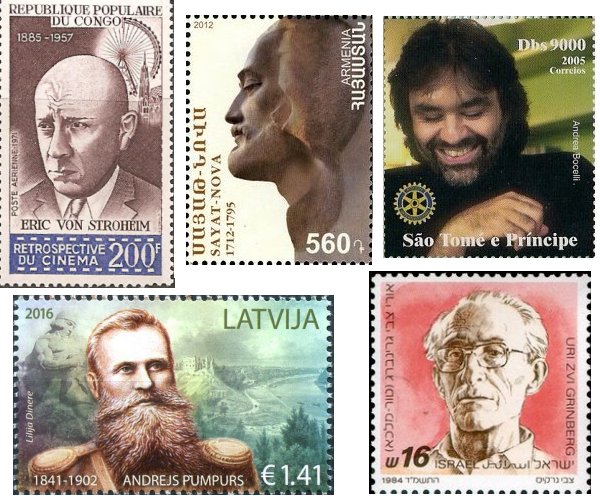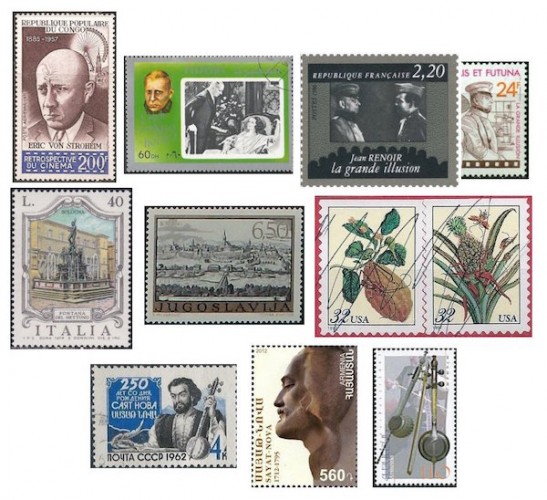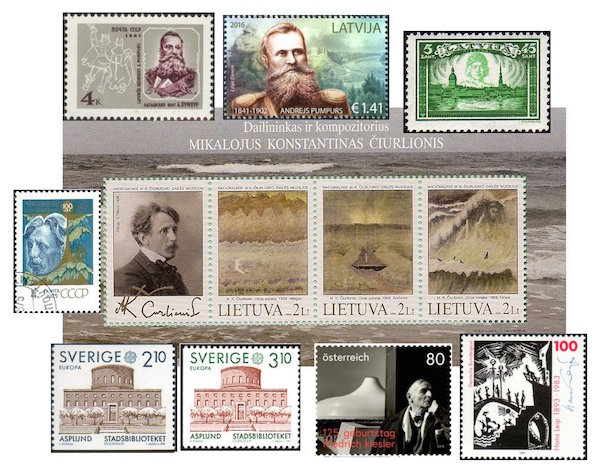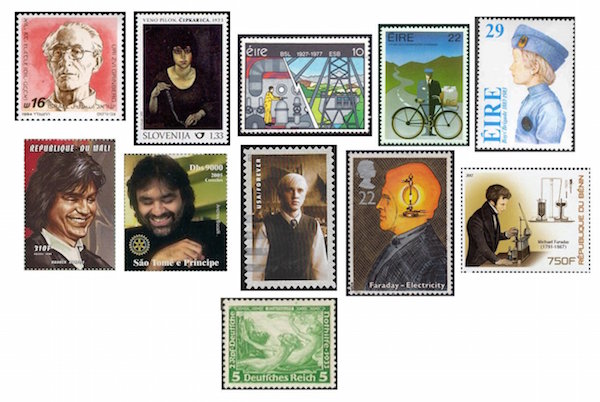The Arts on Stamps of the World — September 22
An Arts Fuse regular feature: the arts on stamps of the world.

By Doug Briscoe
We’ve recently had occasion here, a couple of times, to mention the name of Erich von Stroheim (September 22, 1885 – May 12, 1957), and now his birthday has arrived. Undeniably a great talent, he was also a bit of a charlatan. Born in Vienna to Jewish parents, he passed himself off as a count when he arrived at Ellis Island in 1909. He acted in bit parts in films such as D.W. Griffith’s Intolerance, for which Stroheim was also one of many assistant directors. When America entered World War I he played sneering, brutal German villains, the prototypical “Hun”. He directed his own first film, and acted in it, in 1919. His first great achievement, a milestone in cinematic history, was the magnificent Greed (1924), based on Frank Norris’s McTeague. This massive film, said to be the first feature shot on location, ran for an incredible ten hours; needless to say, the studio wasn’t having any of that and ordered the movie cut to a “reasonable” length. Tragically, most of the excised material was promptly destroyed. Stroheim’s most famous acting role was no doubt that of Norma Desmond’s loyal servant Max in Sunset Boulevard. We just saw two of these same stamps a couple of weeks ago for the birthday of Jean Renoir, but I trot them out again along with two more, one from Congo PR dating back to 1971, and the other, with a still from a film I don’t recognize (your input welcome), from Fujeira.

Another “rerun” stamp today is the one for Italian painter Tommaso Laureti, who died on 22 September 1602. This philatelic reprise is necessitated by the fact that I can’t find any other Laureti stamps, and this one certainly does not do him justice. It shows the Neptune Fountain in Bologna made by Giambologna, for which Laureti’s contribution was merely the drawing (1563) on which the base figures were modeled. Born in Sicily around 1530, Laureti was apprenticed to Sebastiano del Piombo and, after his time in Bologna, also worked in Rome. To do him proper service, here is a link to his Triumph of The Cross fresco (1585) in the Vatican.
On now to the Swiss engraver Matthäus Merian the Elder (22 September 1593 – 19 June 1650), who learned his craft in Zürich and went on his peripatetic way to Strasbourg, Nancy, Paris, Basel, and Frankfurt. In that city he assumed control of a publishing house after the death of his wife’s father and worked on a multi-volume topographical study called Topographia Germaniae, which occupied him from about 1642 until his death, whereupon the task was taken up by his son (guess what his name was). I assume that the engraving of the municipality of Kranj, today in Slovenia, reproduced on a Yugoslavian stamp of 1973, comes from one of these volumes. Another of his children was the distinguished naturalist and scientific illustrator Maria Sibylla Merian (2 April 1647 – 13 January 1717), whose work has shown up on a pair of United States stamps (!) from 1997. Given that I missed her birthday back in April, I show that pair of stamps today.
September 22 is also the day on which the Armenian poet and musician Sayat Nova died in 1795. He was born in either 1712 or 1722. He wrote songs in the Azeri, Turkish, Armenian, and Georgian languages. At the Georgian court he also worked as a diplomat and is credited with having forged an alliance against the Persian Empire. He was banned from the court after falling in love with the king’s sister, thereafter becoming an itinerant ashik (i.e, a sort of bard or troubadour) until 1759, when he was ordained as a priest in the Armenian Apostolic Church. He was killed, aged either around 73 or 83, during an attack on Haghpat monastery by the invading army of the then Shah of Iran. Despite his religiosity, his songs are mostly secular and romantic. About 220 have been attributed to him, though he may have written a great many more. On the Soviet stamp of 1962 he is shown holding a kamancheh (aka kamanche or kamancha), one of several types of plucked and/or bowed string instruments he played. The Armenian stamp came out just five years ago. Next to that I include another stamp showing the kamancheh.
Latvian poet Andrejs Pumpurs (22 September [O.S. 10 September] 1841 – 6 July [O.S. 23 June] 1902) was chosen to attend a German-language school for as long as his poor family could afford it, which was three years, but it was enough to give him a taste for literature and, gifted with a good ear, he retained the legends told by the common folk in his district. Later this would manifest itself in his magnum opus, the epic Lāčplēsis (The Bear Slayer), on which Pumpurs began work around 1867 and which was first published in 1888. In the meantime he had volunteered to fight the Turk in Serbia and completed his education at an officers’ school in Odessa. Later he would develop into an ardent (and sometimes secret) advocate of Latvian culture. He died of rheumatism in Riga. Those interested in the story of Lāčplēsis can find it here. There are Pumpurs stamps from the USSR and Latvia, the latter having been issued just last year. I include also an old 1932 Latvian stamp showing the legendary hero keeping watch over Riga.
We move now to neighboring Lithuania for the painter, composer, and writer Mikalojus Čiurlionis (mi-ca-LO-yus chur-L’YON-is), born on this date (O.S. 10 September) in 1875. He’s remembered more for his paintings than for his other creative work, with Wikipedia telling us, “He has been considered one of the pioneers of abstract art in Europe.” On the musical side, he was a child prodigy who could play by ear at the age of three. He studied at the Warsaw and Leipzig Conservatories. Though his first language was Polish (as was common at the time for the educated population), and he didn’t learn Lithuanian until he was past 30, he became an ardent champion of Lithuanian culture and harmonized many folk songs. Čiurlionis suffered from depression and needed to be institutionalized at the beginning of 1910. He died of pneumonia in a psychiatric hospital the next year at age 35. Most of his 300 paintings are housed in a Kaunas art museum named for him. As for his manuscripts, many were lost during World War II, but even so nearly 400 compositions survive. I recently bought a 2-CD set of his piano miniatures and found them to be in the idiom of Rachmaninov but of passing interest only. Here the large central image is a 2005 Lithuanian souvenir sheet. There are three stamps reproducing his musically inspired trilogy Sonata of the Sea, in which the individual paintings are entitled Allegro, Andante, and Finale. The photograph of Čiurlionis is a label, not a stamp (note absence of denomination). The stamp superimposed at left was issued by the Soviet Union for his centennial in 1975. Many more of Čiurlionis’s works can be seen at this extensive website.

A hop over the Baltic takes us to our next subject, Swedish architect Gunnar Asplund (22 September 1885 – 20 October 1940), a champion of the modernist style as exemplified in his Stockholm Public Library (1924-28), shown on a pair of Swedish stamps from 1987. In his earlier days, Asplund had been more of a neoclassicist. Between 1914 and 1940 he collaborated with architect Sigurd Lewerentz in the design of the Skogskyrkogården, a cemetery that has since been declared a UNESCO world heritage site. Buried there, among other notables, her grave marked with a lovely stone, is Monday’s birthday girl Greta Garbo.
Another architect, but one who was also active as a sculptor and theater designer, was the Austrian-born Frederick (Friedrich) Kiesler (September 22, 1890 – December 27, 1965). He studied painting, but without earning his diploma, in Vienna and went into stage design there and in Berlin. One of his Vienna projects was the presentation of the short film Ballet Mécanique (1924), a collaborative work by Fernand Léger, Dudley Murphy, Man Ray, and composer George Antheil. Kiesler joined the group De Stijl in 1923, but in 1926 moved with his wife to New York City, where he lived for the remainder of his life. As a theoretician he created in the 1950s a series of three-dimensional paintings/installations he called Galaxies. His most noted architectural work, a joint effort with Armand Phillip Bartos and Gezer Heller, is likely the Shrine of the Book in Jerusalem, completed just before his death and shown in the background of Austrian stamp from 2015.
The prolific German writer Hans Leip (22 September 1893 – 6 June 1983), who produced novels, poetry, and plays, is perhaps ironically best remembered as the man who wrote the lyrics to the song “Lili Marleen”. He served on the eastern front in the First World War and was wounded in 1917. He worked as an art critic and began submitting short stories for publication in Hamburg periodicals. He was also a graphic artist at this time and continued producing paintings, sculptures, and engravings alongside his fiction, poems, radio and stage dramas, and screenplays. Though the words for “Lili Marleen” were set down in 1915, they were not set to music (by Norbert Schultze) until 1938. Recorded by singer Lale Andersen in 1939, the song became hugely popular with both sides during World War II. I wasn’t able to identify the art work on the stamp.
Israeli poet Uri Zvi Greenberg (September 22, 1896 – May 8, 1981) was born in the Austro-Hungarian Empire to an Hasidic family and had some of his poems, in both Yiddish and Hebrew, published before he was twenty. He also fought in the First World War—his first book came out while he was serving on the Serbian front—but came home to even more violence in the form of the 1918 pogroms in Lemberg (Lviv). He and his family were fortunate to escape to Warsaw and then Berlin before settling in the Mandate of Palestine in 1923. Even from these early days he warned in his writings of the coming Holocaust. (He also happened to be in Poland when World War II erupted and again managed to escape.) Greenberg was a strong advocate for an independent Israel and served a term in the first Knesset.

Born on precisely the same day, and also an Austro-Hungarian veteran of World War I, the Slovene artist Veno Pilon (22 September 1896 – 23 September 1970) was actually captured by the Russians and wrote of his experience in his autobiography. After the war he studied in Prague, Vienna, and Florence, and went to Paris, where he took up photography. As a painter he produced still lifes, landscapes, and portraits. Information about the expressionist painter is skimpy, even on Slovenian Wikipedia. The stamp shows his portrait of Štefka Batič called Čipkarica (1923).
The Irish painter and designer Robert Ballagh was born on this day in 1943. He started as a rock musician but gave it up in 1966 and was soon receiving commissions for his art, holding his first solo exhibition as early as 1969. Ballagh has also been involved with theater design. His mural Electricity appears on an Irish stamp of 1977 marking the fiftieth anniversary of the Electricity Supply Board, and he has gone on to design another seventy-plus Irish postage stamps, including one depicting a rural mailman and another the centenary of the Boys’ Brigade (both 1983). Ballagh designed the last series of Irish banknotes before the introduction of the euro.
Happy birthday to Italian tenor, pop singer, and songwriter Andrea Bocelli, who turns 59 today. Born with congenital glaucoma, he lost his sight entirely at the age of twelve following a sporting accident. He came to the attention of Luciano Pavarotti with a demo tape of Bocelli’s own song “Miserere”. After performing his first classical concert in December 1993, Bocelli made his operatic debut as Macduff in Verdi’s Macbeth in Pisa in September 1994. The stamps come from opera souvenir sheets from Mali and St Thomas.
English actor Tom Felton (born 22 September 1987) is on an American postage stamp in the Harry Potter set. In the films he plays Draco Malfoy (great name), a nasty little wizard boy who develops into a nasty teenage wizard boy.
He is not from the art world, but Michael Faraday (22 September 1791 – 25 August 1867) is of such importance as a scientist that I feel his name should be much better known. It was he who, in 1831, created the first practical electrical generator. He also discovered benzene. A towering genius born to poverty, he was largely self-taught and made many other important discoveries. Today is the 150th anniversary of his death.
Today is the 148th anniversary of the first performance of Wagner’s Das Rheingold in Munich (1869). The stamp is one from a set issued in 1933, the very first stamps issued by the newly inaugurated Nazi government.
It’s the 115th anniversary of the birth of John Houseman (September 22, 1902 – October 31, 1988). Did you know he was born Jacques Haussmann in Romania?
A graduate of the University of Massachusetts with a B.A. in English, Doug Briscoe worked in Boston classical music radio, at WCRB, WGBH, and WBUR, for about 25 years, beginning in 1977. He has the curious distinction of having succeeded Robert J. Lurtsema twice, first as host of WGBH’s weekday morning classical music program in 1993, then as host of the weekend program when Robert J.’s health failed in 2000. Doug also wrote liner notes for several of the late Gunther Schuller’s GM Recordings releases as well as program notes for the Boston Classical Orchestra. For the past few years he’s been posting a Facebook “blog” of classical music on stamps of the world, which has now been expanded to encompass all the arts for The Arts Fuse.
